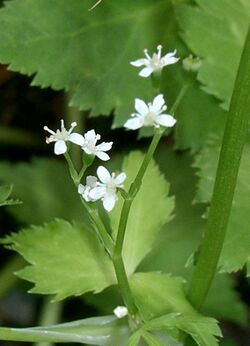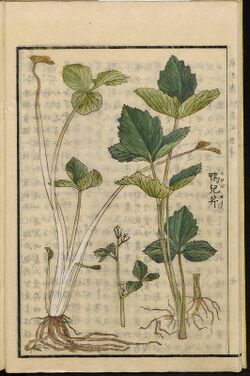Biology:Cryptotaenia japonica
| Cryptotaenia japonica | |
|---|---|

| |
| Scientific classification | |
| Kingdom: | Plantae |
| Clade: | Tracheophytes |
| Clade: | Angiosperms |
| Clade: | Eudicots |
| Clade: | Asterids |
| Order: | Apiales |
| Family: | Apiaceae |
| Genus: | Cryptotaenia |
| Species: | C. japonica
|
| Binomial name | |
| Cryptotaenia japonica Hassk.
| |
| Synonyms[1] | |
| |
Cryptotaenia japonica, also called East Asian wildparsley,[2] Japanese cryptotaenia,[3] Japanese honewort,[3] white chervil[4] mitsuba,[5] Japanese wild parsley, stone parsley, honeywort, san ip, trefoil, and san ye qin (from Chinese: 三叶芹; pinyin: sānyè qín) is a plant species native to Japan , Korea, and China .[6] The plant is edible and is commonly used as a garnish and root vegetable in Japan,[7] and other Asian countries.[8]
Culinary uses

Cryptotaenia japonica is raised as a seasoning (similar to angelica). Like parsley, the flavor is clean and refreshing with a slightly bitter taste which some describe as celery-like. The sprouts are used in salads and soup.[citation needed]
In Japan, it is commonly used as a garnish in soups or atop entrees or as a sushi ingredient. The white stems are blanched while they're tender, and have a taste similar to coriander.[9] Two main regional varieties exist, the green Kansai type, and the white Kantō type.[9]
Nutritional benefits
Mitsuba's dark green leaves, stems, and pods have an extensive nutritional profile, including high levels of calcium and vitamin C.[citation needed]
References
- ↑ The Plant List: A Working List of All Plant Species, http://www.theplantlist.org/tpl1.1/record/kew-2746577, retrieved 19 July 2016
- ↑ Korea National Arboretum (2015). English Names for Korean Native Plants. Pocheon: National Arboretum. pp. 426. ISBN 978-89-97450-98-5. http://www.forest.go.kr/kna/special/download/English_Names_for_Korean_Native_Plants.pdf. Retrieved 6 December 2016.
- ↑ 3.0 3.1 {{citation | mode = cs1 | title = Cryptotaenia japonica | work = Germplasm Resources Information Network (GRIN) | url = | publisher = [[Organization:Agricultural Research ServAgricultural Research Service (ARS), United States Department of Agriculture (USDA) | access-date = }}
- ↑ Hurst, Kim (2015). Hidden Histories Herbs - The Secret Properties of 150 Plants. London: Timber Press. p. 56. ISBN 9781604696189.
- ↑ Plants for a Future, https://pfaf.org/user/plant.aspx?LatinName=Cryptotaenia+japonica, retrieved 12 May 2016
- ↑ Flora of China Vol. 14 Page 80, 鸭儿芹 ya er qin, Cryptotaenia japonica Hasskarl, Retzia. 1: 113. 1855.
- ↑ "Gardening Articles :: Edibles :: Herbs :: National Gardening Association". garden.org. http://www.garden.org/subchannels/edibles/herbs/?q=show&id=700.
- ↑ "Cryptotaenia japonica f. atropurpurea - Plant Finder". missouribotanicalgarden.org. http://www.missouribotanicalgarden.org/PlantFinder/PlantFinderDetails.aspx?taxonid=265469&isprofile=0&.
- ↑ 9.0 9.1 Sanderson, Helen; Renfrew, Jane M. (2005). Prance, Ghillean; Nesbitt, Mark. eds. The Cultural History of Plants. Routledge. p. 107. ISBN 0415927463.
External links
Wikidata ☰ Q1352532 entry
 |

